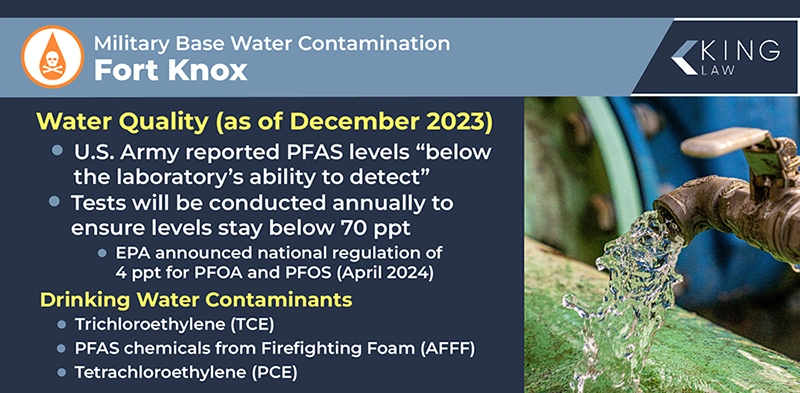
Fort Knox Water Contamination Lawsuit Overview
Originally known as Camp Knox, Fort Knox was established in 1918 and became an official military post in 1932. The U.S. Bullion Depository was built here to provide bombproof storage for gold reserves and later held the original U.S. Constitution, Declaration of Independence, the Magna Carta, and Abraham Lincoln’s Gettysburg Address draft. From 1940 on, Fort Knox has been The U.S. Army Armor Headquarters and home to many different training schools. Every enlisted Army armored soldier serves at Fort Knox at least once.
Fort Knox has had long-standing issues with water contamination. Toxins that have affected drinking water quality at Fort Knox include per- and poly-fluoroalkyl substances (PFAS), trichloroethylene (TCE), and tetrachloroethylene (PCE). PFAS has been of particular concern, stemming from the use of Aqueous Film Forming Foam (AFFF), a firefighting foam used at military bases for decades. This foam contained PFAS, which then entered the soil, contaminating groundwater and migrating into drinking water supplies. Individuals exposed to PFAS at Fort Knox may be eligible to file a contamination lawsuit if they’ve developed a related illness such as testicular cancer, thyroid cancer, bladder cancer, or kidney cancer.
Fort Knox Water Contamination Lawsuit Updates
March 23, 2024 – Fort Knox Water Contamination Lawsuit Status
Veterans and their family members who were exposed to PFAS at Fort Knox and developed a related illness may be eligible to file a lawsuit and recover damages. Thousands of victims across the United States continue to file claims against chemical manufacturers for their wrongful exposure.
September 1, 2019 – DoD Cites Widespread Use of AFFF and its Environmental Risks
The dangers of PFAS have been known since the 1960s but many testing efforts only began a decade ago and cleanup projects are still underway or unstarted. In 2019, the Department of Defense (DoD) released a report acknowledging the widespread use of firefighting foam and its environmental risks. Since the report, awareness of PFAS contamination at military bases has spread with more veterans taking legal action through AFFF lawsuits.
On this page:
Fort Knox Water Contamination Lawsuit Overview
Fort Knox Water Contamination Lawsuit Updates
Historical Background of Toxic Exposure at Fort Knox
Fort Knox Water Contamination Map
Contaminants Found in Fort Knox Drinking Water
Current Water Quality at Fort Knox
Health Risks and Symptoms Linked to Drinking Water at Fort Knox
Eligibility Criteria for Fort Knox Water Contamination Lawsuit
Fort Knox Water Contamination Settlement and Payout Amounts
How to File a Fort Knox Water Contamination Lawsuit
Historical Background of Toxic Exposure at Fort Knox
Fort Knox has long-standing issues with PFAS, TCE, and PCE water contamination. Chemicals in the drinking water put military members and their families at risk of serious illnesses as they consume and use the toxic water.

December 2023 – PFAS Levels Below 70 PPT
The U.S. Army reports that December 2023 PFOA+PFOS results fell below detectable limits, noting their levels remain below 70 ppt. The next testing event is supposed to take place in March 2024.
Note: The Environmental Protection Agency (EPA) set an interim updated health advisory of 0.02 ppt for PFOS and 0.004 ppt for PFOA (two chemicals in the PFAS chemical group).
August 2023 – Fort Knox Has Maximum PFOS Detection of 5,800 PPT
According to the Environmental Working Group (EWG), as of August 2023, Fort Knox had a maximum PFAS detection level of 5,800 ppt.
March 2022 – Contamination Assessments at Fort Knox Underway
As of March 2022, Fort Knox PFAS Progress reports list Fort Knox as “PA/SI Underway,” which indicates preliminary assessments and site investigations are underway.
February 2021 – Water Samples Show Significant Levels of PFAS
Fort Knox groundwater samples taken in February 2021 identified levels of PFOS at 4,800 ppt, 4,700 ppt, and 5,800 ppt. Levels of PFOA were at 360 ppt, 340 ppt, and 600 ppt. And levels of PFBS were at 340 ppt, 350 ppt, and 340 ppt. These samples were from Building 5223, a fire station at the base.
2007 – Corrective Action Addresses TCE Groundwater Contamination
In 2007, the Army took corrective actions to address high concentrations of TCE and PCE that were a source of groundwater contamination. Efforts were ongoing and were recommended again in 2017.
Fort Knox Water Contamination Map

The above map represents Fort Knox groundwater contamination. It notes the source and spread of PFAS, TCE, and PCE from various areas of the military base. As these chemicals enter the soil, they impact groundwater which contributes to the base’s drinking water supplies. The spreading contaminants have also been a concern for communities surrounding Fort Knox.
Contaminants Found in Fort Knox Drinking Water
Multiple contaminants have been found in Fort Knox drinking water. Three cancer-causing toxins noted in quality and screening reports include TCE, PCE, and PFAS.
Per- and Poly-Fluoroalkyl Substances (PFAS)
PFAS contamination at Fort Knox stems from the use of AFFF. This firefighting foam has been used since the 1970s to put out fires on base. There has been a push for fluorine-free foams, but for decades military members and their families have been exposed to PFAS. PFAS can lead to testicular cancer, kidney cancer, thyroid cancer, thyroid disease, and bladder cancer.
Trichloroethylene (TCE)
TCE is an industrial solvent often used by the military as a degreaser and chemical intermediate. TCE has been identified in Fort Knox water and is linked to liver and kidney problems, as well as cancer.
Tetrachloroethylene (PCE)
PCE is another industrial solvent used for degreasing, stripping, cleaning, and lubricating. It has been identified in Fort Knox water and is linked to serious illnesses like bladder cancer, non-Hodgkin’s lymphoma, and multiple myeloma.
Current Water Quality at Fort Knox
The U.S. Army website notes that PFAS levels are below their lab’s ability to detect and that testing is meant to ensure levels stay below 70 ppt. The most recent test results were done in December 2023 and involved finished drinking water that is treated and purchased by the Army.
Despite the current drinking water quality, numerous soldiers, family members, and civilians have already been impacted by the toxic water. The current Fort Knox population sits at 26,000 and isn’t inclusive of the thousands living in surrounding communities.

Water Treatment Efforts at Fort Knox
The September 2023 Fort Knox Army Cleanup Program Installation Action Plan notes the ongoing investigations into PFAS contamination. Various efforts have been made to address TCE and PCE concentrations, including biostimulation, bioaugmentation, and remedial injections, as well as ongoing testing.
Health Risks and Symptoms Linked to Drinking Water at Fort Knox
The drinking water contaminants at Fort Knox (PCE, TCE, and PFAS) are linked to the following health conditions:
- Bladder cancer
- Breast cancer
- Hodgkin’s lymphoma
- Kidney cancer
- Leukemia
- Liver cancer
- Lymphoma
- Multiple myeloma
- Neurological disorders
- Non-Hodgkin’s lymphoma
- Prostate cancer
- Testicular cancer
- Thyroid cancer
- Thyroid disease
- Ulcerative colitis
Our law firm is currently evaluating cases where individuals have been diagnosed with:
- Bladder Cancer
- Breast Cancer
- Hodgkin’s Lymphoma
- Kidney Cancer
- Leukemia
- Liver cancer
- Multiple-Myeloma
- Non-Hodgkin’s Lymphoma
- Pancreatic Cancer
- Prostate Cancer
- Testicular Cancer
- Thyroid Cancer
- Thyroid Disease
- Ulcerative Colitis
You should contact a health professional as soon as possible if you experience any symptoms or adverse health effects from drinking contaminated water.
Eligibility Criteria for Fort Knox Water Contamination Lawsuit
If you were exposed to toxins at Fort Knox and developed a related illness, you may be able to file a water contamination lawsuit. By taking action, you can hold chemical manufacturers responsible for wrongful exposure and earn compensation to help offset lost wages, medical bills, and other damages. Eligibility requirements include:
- Acceptable exposure duration: We look for at least six months of toxic exposure to build a strong PFAS lawsuit. PFAS is a chemical that builds up in the body, posing a higher risk with long-term exposure.
- A related diagnosis: You must have a diagnosis linked to your toxic exposure. We are reviewing cases of testicular cancer, thyroid cancer, thyroid disease, bladder cancer, kidney cancer, and other illnesses.
Our law firm is currently evaluating cases where individuals have been diagnosed with:
- Bladder Cancer
- Breast Cancer
- Hodgkin’s Lymphoma
- Kidney Cancer
- Leukemia
- Liver cancer
- Multiple-Myeloma
- Non-Hodgkin’s Lymphoma
- Pancreatic Cancer
- Prostate Cancer
- Testicular Cancer
- Thyroid Cancer
- Thyroid Disease
- Ulcerative Colitis
Reach out to King Law today to schedule a consultation. We will review your case and help confirm your eligibility for compensation.
Fort Knox Water Contamination Settlement and Payout Amounts
We anticipate water contamination settlements to payout between $30,000 and $500,000. However, exact amounts vary based on the case. Related lawsuits have resulted in $100,000-$300,000 with average settlements at $250,000.
Higher payouts are possible under circumstances like diagnosis at a young age, diagnosis of a severe illness, or instances of long-term exposure. These scenarios may extend toward $1,000,000. Conversely, cases with less substantiation may fall closer to $30,000-$75,000. You may have the option to go to trial, but trial verdicts present the risk of earning no compensation if the ruling is not in your favor.
How to File a Fort Knox Water Contamination Lawsuit
To file a Fort Knox water contamination lawsuit, you should:
- Consult with an attorney who has experience handling successful environmental and toxic exposure cases.
- Gather all evidence related to your time at Fort Knox, toxic exposure, and diagnosis of a related illness. This can include military directives, discharge paperwork, medical records, and expert testimonies.
- Your attorney will draft and file the claim on your behalf. The complaint will detail who you deem responsible for your toxic exposure, how you were exposed, and how you have suffered as a result.
- Your attorney can negotiate a settlement or may encourage you to go to trial. They will help you review your options to make the best decision for your situation.
- Ideally, you will then be awarded compensation to help cover medical costs, lost wages, and other damages.
While the legal process may seem daunting, our attorneys are ready to support you through the entire process and advocate on your behalf.
Evidence to Support Your Fort Knox Claim
To build a successful Fort Knox water contamination claim, you should seek the following evidence:
- Proof you were stationed at Fort Knox, which may include military directives, deployment records, and discharge paperwork
- Proof of at least six months of exposure and any details around how you were exposed and to what toxins
- Medical records proving you received a diagnosis related to your exposure
- Medical records detailing the severity of your illness, the prognosis, and suggested treatments
- Official reports or studies detailing the toxins at Fort Knox and their associated health risks
- Any other testimonies, reports, or documentation requested by your attorney to support the case
Keep in mind that adequate evidence to ensure your eligibility for compensation is required. Begin collecting any information you have as soon as possible and seek counsel from an attorney who understands toxic exposure cases.
Fort Knox Water Contamination Lawyers
Finding the right lawyer can have a significant impact on the success of your water contamination lawsuit. King Law offers unmatched legal representation to military veterans and their loved ones. We understand the nuances of toxic exposure cases and know what it takes to get the best result possible. No matter where you are in the process, we are here to help with a steadfast commitment to fighting for the compensation you deserve.
Frequently Asked Questions (FAQs)
For additional information regarding Fort Knox water contamination lawsuits, review the following answers to frequently asked questions.

